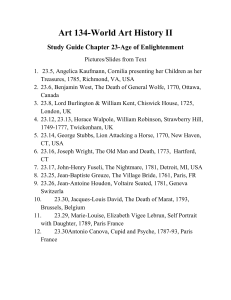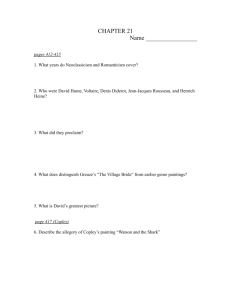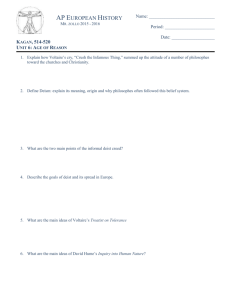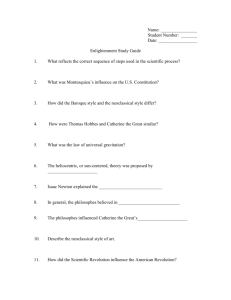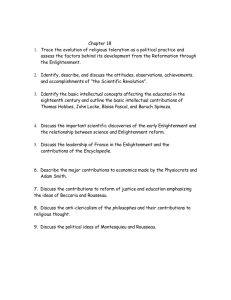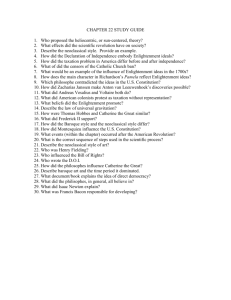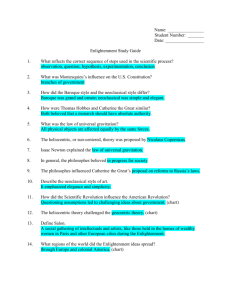The Enlightenment - Mount St. Joseph High School Teachers' Web
advertisement
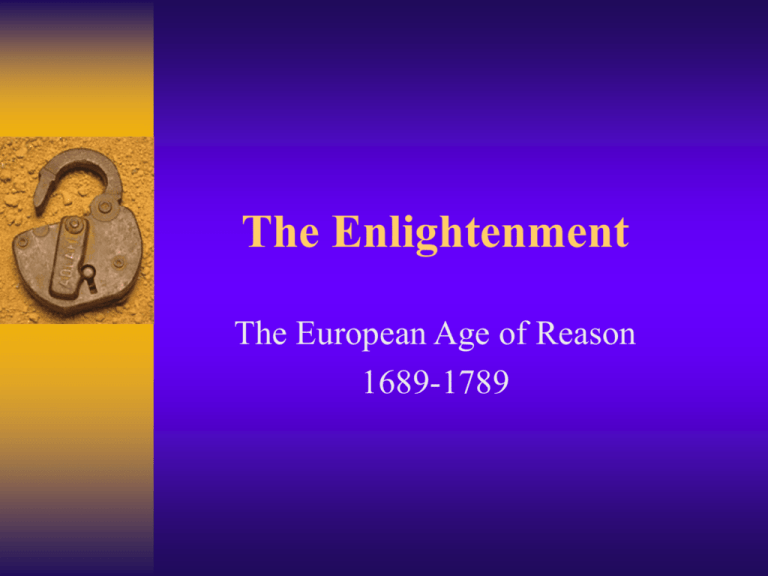
The Enlightenment The European Age of Reason 1689-1789 Origins of the Enlightenment The ideals of humanism from the Renaissance permeate society. Rediscovery of classical texts influences the new philosophers. The Scientific Revolution convinces many that the world can be understood through natural laws. The Wars of Religion persuade many that toleration is the only way for civilization to survive. The Doctrine of Progress Philosophes believed in the progress of human beings. Human beings were basically good, but corrupted by society; therefore, human institutions needed reform Marquis de Condorcet (1743-1794) made argument in Progress of the Human Mind John Locke (1632-1704) Two Treatises on Civil Government:justified supremacy of Parliament; natural rights Essay Concerning Human Understanding (1690): tabula rasa (“blank slate”) – considered one of most important Enlightenment works – all human knowledge is the result of sensory experience: thus, human progress is in the hands of society—education! Deism secular world view: first time in human history; marked end of age of religion natural science and reason deism: God created universe and then stepped back and left it running (like a clock) – prime mover Grew out of Newton’s theories regarding natural law Thomas Paine, Age of Reason: advocates deism Voltaire also advocated deism over Christianity. Voltaire (1694-1778) François Marie Arouet Ardent critic of the Old Regime Wrote essays, letters, plays. Candide (1759) satire criticizing religious persecution and superstition. Voltaire in England Voltaire in imprisoned in France after his ideas offend French authorities. He lived in England from 1726 to 1729. He comes to admire the English toleration of political ideas and religion. Returning to France, he published Letters on the English (1733), admiring English constitutionalism and criticizing French absolutism. Voltaire and Tolerance Voltaire supported toleration in religion and politics, an idea he saw in practice in England. Voltaire defended Jean Calas, a Hugeunot accused of murdering his son lest he convert to Catholicism. He published his Treatise on Tolerance in 1763, convincing authorities to reverse their conviction of Calas in 1765. The Enlightened Despots Catherine the Great Least “enlightened” of the Enlightened Despots westernization: architecture, sculpture, music--supported philosophes reforms:reduced torture, limited religious toleration, some education improvement, increased local control The Enlightened Despots Joseph II (1765-1790) – greatest of the Enlightened despots (“greatest good for greatest number”) Abolished serfdom in 1781, freedom of press, freedom of religion & civic rights, more equitable justice system, made German official language (to assimilate minorities), increased control over Catholic education, expanded state schools, left empire in economic and political turmoil: Leopold I rescind many laws (e.g., serfdom) The Enlightened Despots Frederick the Great – Became a reformer during 2nd half of his reign; ruler was the “first servant of the state” – Religious freedom, education in schools and universities, codified laws, promoted industry and agriculture, encouraged immigration – Social structure remained heavily stratified: serfdom; extended privileges for the nobility, Junkers became heart of military; difficult upward mobility for middle class leadership. Baron de Montesquieu (1689-1755) French attorney and philosophe. Believed in no single political system. In Spirit of the Laws (1748) advocated separation of powers amongst executive, legislative, and judicial branches. Diderot and the Encyclopedia Denis Diderot (1718- 1784) edited the Encyclopedia published in 28 vols. Between 1751 and 1772. Voltaire, Rousseau and Montesquieu contributed articles. Jean-Jacques Rousseau (1712-1778) Born in Geneva to Calvinist family He believed rationalism and civilization was destroying rather than liberating the individual; emphasized nature, passion— influenced early Romantic movement Jean-Jacques Rousseau Natural Education – Rousseau believed that in there natural state, humans were virtuous, free, equal, and happy. – Civilization had corrupted them. – Natural education would free children of corruption – Set forth ideas in Emile (1762). – Children would learn through experience (nature, emotional experience), not books. Jean-Jacques Rousseau General Will – Rousseau advocated radical contract form of government in The Social Contract (1762) – Desired freedom, but rejected individualism and focused on his role in society. – People’s opinion would form the “general will” to be carried out by a small government. – He did not favor democracy, but felt that sovereignty laid in the people. Economic Philosophes François Quesnay (1694-1774) – “physiocrats”: opposed to mercantilist economic theory. advocated reform of the agrarian order. Adam Smith (17271790): Wealth of Nations (1776): The “Bible” of capitalism; laissez faire “let do” François Quesnay Women Philosophes Gender theory: women played important role in organizing salons. Salons of Madame de Geoffren and Louise de Warens Mary Wollstonecraft – Vindication of the Rights of Women (1792) Olympe de Gouge Declaration of the Rights of Women Mary Wollstonecraft The Later Enlightenment: Baron Paul d’Holbach (1723-1789): humans were machines governed by outside forces – freewill, God, and immortality of soul were foolish myths – severe blow to unity of the Enlightenment David Hume (1711-76): emphasized limitations of human reasoning (similar to Rousseau) – human mind is nothing but a bundle of impressions; later became dogmatic skeptic that undermined Enlightenment Immanuel Kant (1724-1794): Separated science and morality into separate branches of knowledge. – Science could describe natural phenomena of material world but could not provide a guide for morality High Culture - Travel Elites began to travel for pleasure in greater numbers than ever before. The “grand tour” of Europe became a must for the cultured. People wished to see the ruins of antiquity and the new urban centers throughout Europe. Coffee houses offered a meeting place for people to discuss philosophy and the issues of the day. The Salons Groups organized by women, such as Madame de Pompadour, of wealthy families. Gave a forum to which philosophes could share their ideas. Allowed women a place were they could be taken seriously. Often, the etiquette of the gatherings made things ‘artificial.’ Publishing and Reading Publishing and bookselling became a major commercial enterprise in the 18th century. Newspapers and journals became a part of the daily life of most urban Europeans. Newspapers began to write more about political issues, particularly in England and during the Revolution in France. There was also a large market for “bad books” describing scandals and sex. The Arts: Neoclassicism to Romanticism Literature – The Novel • Novel had its origins in mid 18th century England with the rising demand for fiction from the middle class. • Pioneers included Samuel Richardson and Henry Fielding. • A wide range of topics were covered in novels; they shadowed the plays of the time in dealing with family and social issues of the day The Arts: Neoclassicism to Romanticism Poetry – For 140 years from 1660 to 1800 neoclassical poetry reigned England. – Also known as Augustan poetry, neoclassical used strictly, structurally balanced verses, witty and elegant language with restrained and controlled emotion, the idea being to create a more refined verse. – Amongst the most famous neoclassical poets were John Dryden and Alexander Pope. The Arts: Neoclassicism to Romanticism Poetry – However, in 1798 poets William Wordsworth and Samuel Taylor Coleridge published an anthology Lyrical Ballads, opening the Romantic period of poetry. – Romantic poetry was the complete opposite of Neoclassical. – Romantic poetry used simple language to create the impression that the poet were speaking out loud and usually spoke about common, everyday aspects of life and nature. – Later famous romantic poets of the time were William Blake, Lord Byron, John Keats and Percy Bysshe Shelley. The Arts: Neoclassicism to Romanticism Poetry – Johann von Goethe (1749-1832) • Prolific German writer and poet who’s work encompassed Neoclassical and Romantic elements. • He inspired the literary movement known as Sturm und Drang (Storm and Stress), emphasizing strong emotion experience. • His great works include The Sorrows of Young Werther (1774) and Faust (1801 and 1831) The Arts: Neoclassicism to Romanticism Music – Symphony – Began moving from “light” neoclassical works to more powerful and extended works. • Franz Joseph Hayden • Wolfgang Amadeus Mozart – Powerful extended symphonies that reflected the emotion of the Romantic movement. • Ludwig von Beethoven The Arts: Neoclassicism to Romanticism Visual Arts – Neoclassical Art is a severe and unemotional form of art harkening back to the grandeur of ancient Greece and Rome. Its rigidity was a reaction to the overdone Rococo style and the emotional charged Baroque style. The rise of Neoclassical Art was part of a general revival of interest in classical thought, which was of major importance in the Enlightenment and the American and French revolutions. Jacques-Louis David (1748–1825) The most famous painter in Europe in the late 1700s and early 1800s. He breathed new life into history painting with his rigorously constructed compositions David could be petty, graceless, and abrasive. Intensely competitive, he was confident and even boastful of his talent. Jacques-Louis David - The Lictors Bring to Brutus the Bodies of His Sons Jacques-Louis David – Oath of the Horatii Benjamin West, The Death of General Wolfe (1770) Benjamin West, Penn's Treaty with the Indians (1771) The Arts: Neoclassicism to Romanticism Romanticism might best be described as anticlassicism. A reaction against Neoclassicism, it is a deeply-felt style which is individualistic, exotic, beautiful and emotionally wrought. Although Romanticism and Neoclassicism were philosophically opposed, they were the dominant European styles for generations, and many artists were affected to a lesser or greater degree by both. Artists might work in both styles at different times or even combine elements, creating an intellectually Romantic work using a Neoclassical visual style, for example. Jacques-Louis David – Bonaparte Crossing the Alps J.M.W. Turner - Snowstorm: Hannibal and His Army Crossing the Alps Popular Literature Designed for those who could barely read or what was going to be read aloud. – Three main forms: • Religious and superstitious works • Almanacs • Entertainment – satire, tales, fables. Oral traditions continued with stories of daily life. Mass Education Religious wars increased literacy and education across Europe (particularly in Protestant nations) Schooling was designed to maintain the social order and piety. Many peasants opposed sending their children to school when they could help the family work. Mass Education Education in Western Europe was driven by demand and the needs of the community. In Prussia and Austria, education became a state function – Austria – Habsburg General School Ordinance of 1774. • Schools in every parish. • Train teachers • Education was said to be compulsory – Prussia – Frederick the Great enacted similar reforms with less enthusiasm. Recreation for the Masses The spread of pubs and taverns became popular. Festivals continued to be of importance. First “spectator sports” become popular. – Blood sports such as boxing and cock fighting mixed with gambling popular with commoners. – Horse racing also popular. – Growing separation between elite and masses in entertainment.
